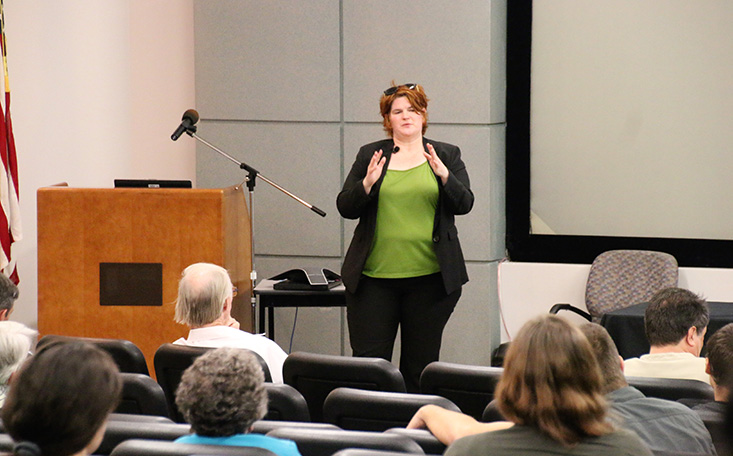Summary by Sean Beckwith, PhD student
ST. PETERSBURG, FL – Dr. Tina van De Flierdt from Imperial College London addressed the crowd gathered at the FWRI Steidinger Auditorium on Friday afternoon with geological evidence of past ocean warming events and chemical techniques for understanding the role of warming oceans on the fate of continental ice sheets.
In case you missed the talk, here are 5 takeaways:
1.There are major differences between ice on East Antarctica and West Antarctica
Viewing a graphical cross-section of Antarctica that van De Flierdt showed early in her talk, it was easy to see one striking difference between the two halves of the continent: East Antarctic ice sheets rest mostly on continental rock above sea level – covering mountains, etc. – while the West Antarctic ice sheets rest on bedrock that is largely found below sea level.
This key difference means that ocean water has the ability to interact much more greatly with West Antarctic ice, and, in the case of a warming ocean, there’s more chance for the ocean to cause the ice sheets to melt.
2. Worst-case scenario and Not-as-bad scenario: both pretty bad
Based on current IPCC projections, a worst-case scenario would plunge us back into an Eocene-like greenhouse earth. Other, more supported scenarios (of 2 to 3.5°C warming) could still result in 10 to 30 meters of sea level rise (SLR).
There is scientific consensus that SLR greater than the 10 to 30 meters that would come from the melting of Greenland and West Antarctica continental ice, requires melting of some of the East Antarctica continental ice, as well.
3. Mud can provide a good record of glacial erosion
While most paleoceanographers are unhappy to find sediment cores of only mud and none of the useful bioindicator species of foraminifera, van De Flierdt says, “Give it to me, I can do something with it!”
She employs trace metal analysis on isotopes of the elements Samarium and Neodymium.
4. Late Pleistocene similarities to Pliocene sea level variation
Low lying areas of East Antarctica contributed to sea level rise in both the Pliocene and Late Pleistocene geological epochs.
5. More warming in the pipeline – not too late to do something about it
Paleoclimate data tell us that there is already more warming in the pipeline. As an analogy, van De Flierdt explained that it’s like turning on an oven – it takes time to heat up. Ice sheets can be especially slow to respond to climate changes and they may take hundreds to thousands of years to melt.
One thing missing from common discussions about climate change is an appreciation for the proper time scale. Even focusing on the next 100 years is very shortsighted, in terms of continental ice melt. And, while our actions have committed us to very long responses in climate, there is still a chance to avoid any serious, sustained warming of the planet if we can find a way to turn down the heat – i.e., reduce CO2 concentrations in the atmosphere.
